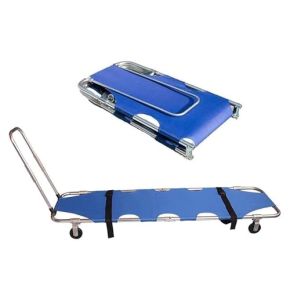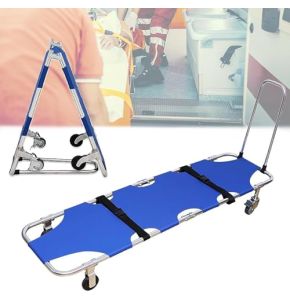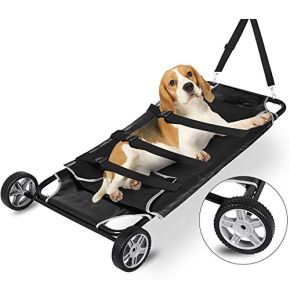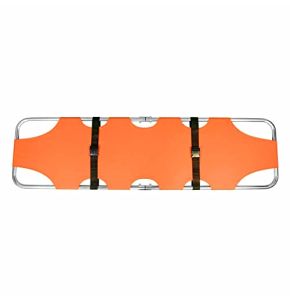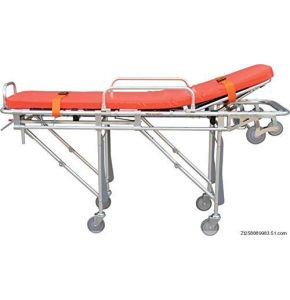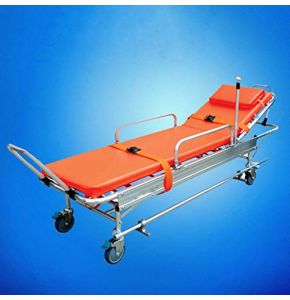Stretcher Cart
18/11/2024 311
GLJY Automatic Folding Leg Stretcher with Aluminum Alloy Emergency Bed Trolley - Position Control
18/11/2024 301
Medical Stretcher Cart: Ensuring Safe Patient Transport
In the medical field, patient transport is a crucial task that requires reliable and secure equipment. The stretcher cart is an indispensable tool for moving patients between different hospital departments, to operating rooms, or during ambulance transfers. In emergency situations, it offers speed and efficiency, which are essential for healthcare professionals. With this equipment, patients are transported safely, thereby improving their care.
The Function of the Stretcher Cart
The stretcher cart is designed to transport patients securely and comfortably. It facilitates movements within the healthcare facility, whether for consultations, examinations, or surgical interventions. In emergencies, this equipment allows medical teams to respond quickly, which can be crucial for the patient's recovery. The ambulance stretcher cart is used for transporting patients from the incident site to the hospital, ensuring care from the very first moments.
Different Types of Stretcher Carts
There are various types of stretcher carts tailored to the specific needs of healthcare facilities. The standard transport stretcher cart is used for routine patient movements within the hospital. It is designed to provide maximum comfort and safety. Specialized carts, such as radiotransparent models, are used for medical imaging examinations. They allow for radiographs or scans to be performed without moving the patient, which is especially useful for individuals in critical condition.
The hydraulic stretcher cart is equipped with a system that allows easy adjustment of the bed's height and inclination. This makes it easier for caregivers to quickly adjust the patient's position. Some models use a gas spring for smooth and effortless adjustments. These features enhance patient comfort and the efficiency of the medical staff.
Important Technical Features
Modern stretcher carts come with numerous features to ensure patient safety and comfort. Hydraulic or electric systems allow for effortless position adjustments. Safety accessories, such as retractable side barriers and straps, prevent falls. Some models are equipped with supports for infusions or other medical equipment, enabling continuous care during transport.
Multi-directional wheels make it easy to navigate through narrow corridors and confined spaces. Brakes and locking systems ensure stability during transfers or stops. These features are essential to guarantee safety during patient transport, especially in emergency situations.
Ergonomics and Maneuverability
Ergonomics is a key aspect of stretcher cart design. They are built to be easy to use by medical staff, reducing fatigue and the risk of injuries. Ergonomic handles provide a comfortable grip, and intuitive controls make necessary adjustments simple. Maneuverability is crucial for moving patients quickly and effortlessly, which is important in emergency situations.
Some carts are convertible into transfer chairs. This feature offers additional flexibility, allowing for quick switching between modes as needed. This reduces the number of maneuvers required, minimizing risks for the patient and making the work of caregivers easier.
Maintenance and Hygiene
In a medical environment, hygiene is paramount to prevent infections. Stretcher carts are made from durable and easy-to-clean materials, such as stainless steel or special plastics. They withstand the powerful disinfectants used in hospitals, ensuring a high level of cleanliness. Regular maintenance is necessary to ensure the equipment functions properly.
Maintenance includes checking hydraulic or electric systems, brakes, wheels, and safety accessories. Regular inspections ensure that the cart is always ready to be used safely. Well-maintained equipment is essential for the smooth operation of a healthcare facility.
Choosing the Right Cart for Your Facility
It is important to choose a cart that fits the specific needs of your facility. On our Placemed marketplace, we offer a wide range of high-quality stretcher carts. Whether you need an emergency model, an ambulance cart, or a hydraulic model, you will find the equipment that meets your requirements.
Our products are designed to provide safety, comfort, and efficiency. They incorporate the latest innovations to assist healthcare professionals and improve patient care. Investing in quality equipment ensures the smooth functioning of your facility and the well-being of your patients.
Do not hesitate to browse our selection on Placemed. We are here to help you choose the best equipment for your healthcare facility.
 Francais
Francais 